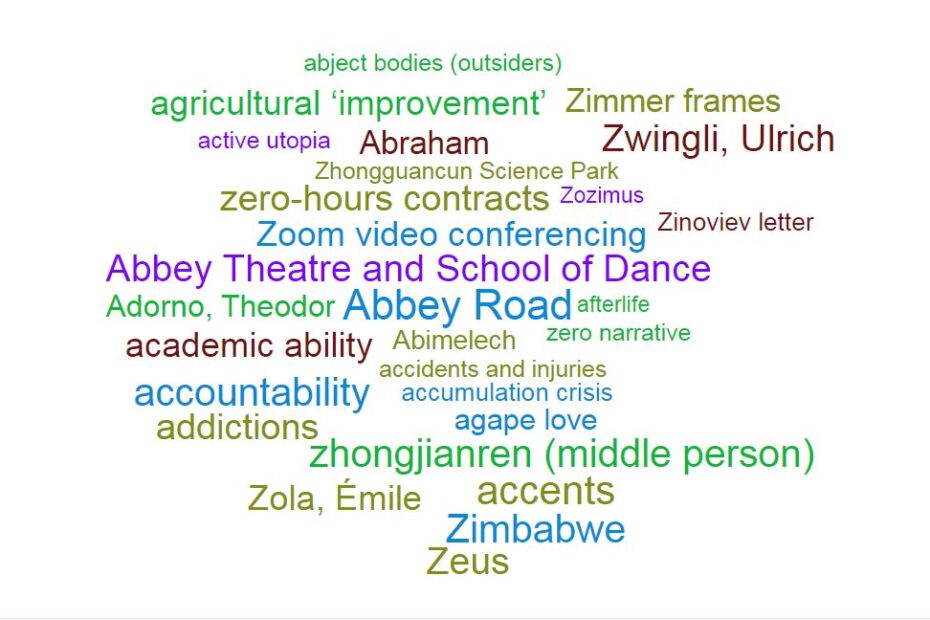To mark National Indexing Day 2024 on Thursday 28th March, this word cloud[1] includes ‘A’ and ‘Z’ headings from a selection of my indexes.
The indexable elements of a book belong to various categories of information. In her textbook, Indexing: the Manual of Good Practice, Pat Booth provides a list of 31 categories[1]. The word cloud provides examples of some of them, highlighted in the discussion below, with their category labels from Booth’s list in bold type.
People can either be indexed as individuals by name, or by types of people. Both are evident in this word cloud. Personal names shown here range from Biblical figures (Abraham and Abimelech) to a 20th century novelist and journalist (Zola, Émile). Along the timeline we also find a 15th century theologian (Zwingli, Ulrich), a 19th century street poet (Zozimus) and a 20th century philosopher (Adorno, Theodor). There is an example of a type of person in this word cloud too, the term zhongjianren (middle person) describes a person by their role in a business context.
Organisations include the Abbey Theatre in Dublin and, on the other side of the globe, Zhongguancun Science Park in Beijing.
The category of places is represented here by Zimbabwe and implied in the entries for organisations in China and Ireland. In 2023 I created a word cloud entirely consisting of places mentioned in my indexes between March 2022 and 2023. The accompanying blog post discusses some of the issues involved in indexing places names.
The above categories (people, organisations, places) are ones that I mark in my indexing software. I also mark categories specific to my subject specialisms, for example, when I am indexing literary studies I mark document titles and literary movements. I use macros to add coded notes to headings in these categories, an addition which takes less than a second. Later, when I am editing the index, I can choose to focus on these categories one at a time, for example, displaying the people in the index and hiding all the other types of information. This allows me to make decisions for consistent coverage in that category.
Other categories identified by Booth include the following:
- events, which can be general, such as accidents and injuries, or can be specific such as the American Civil War
- instruments and tools such as the Zimmer frame
- activities such as Zoom video conferencing (note how tweaking the wording to ‘Zoom software’ would emphasise the tool rather than the activity)
- qualities and attributes would include accountability, academic ability or accents
- artefacts such as the Zinoviev letter, although again, a slight change in wording to ‘Zinoviev letter scandal’, and the emphasis is on an event rather than an artefact.
An indexer’s role is to provide access routes to the information within each book, and sometimes it is helpful to think in terms of categories or types of information during the indexing process. To find out more about indexing visit the Society of Indexers website.
A list of my indexes is available here.
[1] Word Cloud generated in Word It Out.
[1] Booth, Pat, Indexing: The Manual of Good Practice (K. G. Saur, 2001) pp 54-55
